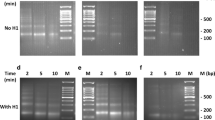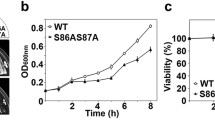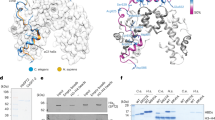Abstract
We have isolated and characterised the pht1 gene from the fission yeast Schizosaccharomyces pombe. The sequence of the predicted translation product has revealed a striking similarity to the family of H2A.F/Z histone variant proteins, which have been found in a variety of different organisms. Cells deleted for the pht1 gene locus grow slowly, exhibit an altered colony morphology, increased resistance to heat shock and show a significant decrease in the fidelity of segregation of an S. pombe minichromosome. We propose that the histone H2A variant encoded by the pht1 gene is important for chromosomal structure and function, possibly including a role in controlling the fidelity of chromosomal segregation during mitosis.
Similar content being viewed by others
References
Allis CD, Glover CVC, Bowen JK, Gorovsky MA (1980) Historic variants specific to the transcriptionally active, amitotically dividing macronucleus of the unicellular eukaryote, Tetrahymena thermophila, Cell 20:609–618
Aves SJ, Durkacz BW, Carr AM, Nurse P (1985) Cloning, sequencing and transcriptional control of the Schizosaccharomyces pombe cdc10 ‘start’ gene. EMBO J 4:457–463
Beach D, Nurse P (1981) High-frequency transformation of the fission yeast Schizosaccharomyces pombe. Nature 290:140–142
Choe J, Schuster J, Grunstein M (1985) Organisation, primary structure and evolution of histone H2A and H2B genes of the fission yeast Schizosaccharomyces pombe. Mol Cell Biol 5:3261–3269
Dalton S, Robins AJ, Harvey RP, Wells JRE (1989) Transcription from the intron-containing chicken historic H2A.F gene is not S-phase regulated. Nucleic Acids Res 17:1745–1756
Donahue PR, Palmer DK, Condie JM, Sabatini LM, Blumenfeld M (1986) Drosophila histone H2A.2 is associated with the interbands of polytene chromosomes. Proc Natl Acad Sci USA 83:6878–6882
Durkacz BW, Carr AM, Nurse P (1996) Transcription of the cdc2 cell cycle control gene of the fission yeast Schizosaccharomyces pombe. EMBO J 5:369–373
Ernst SG, Miller H, Brenner CA, McGrath C, Francis S, McIsaac R (1987) Characterization of a cDNA clone coding for a sea urchin histone H2A variant related to the H2A.F/Z histone protein in vertebrates. Nucleic Acids Res 15:4629–4644
Feinberg, AP, Vogelstein B (1983) A technique for radiolabelling DNA restriction endonuclease fragments to high specific activity. Anal Biochem 132:6–13
Fernandez-Sarabia MJ, Fantes PA (1990) Ribonucleotide reductase and its regulation during the cell cycle. Trends Genet 6:275–276
Forsburg S, Nurse P (1991) Cell cycle regulation in the yeasts Saccharomyces cerevisiae and Schizosaccharomyces pombe. Ann Rev Cell Biol 7:227–256.
Gordon CB, Fantes PA (1986) The cdc22 gene of Schizosaccharomyces pombe encodes a cell cycle-regulated transcript. EMBO J 5:2981–2985
Green GR, Patel JC, Hecht NB, Poccia DL (1991) A complex pattern of H2A phosphorylation in the mouse testis. Exp Cell Res 195:8–12
Grimm C, Kohli J, Murray JM, Maundrell K (1988) Genetic engineering of Schizosaccharomyces pombe: a system for gene disruption and replacement using the ura4 gene as a selectable marker. Mol Gen Genet 215:81–86
Gutz M, Heslot H, Leupold U, Loprieno N (1974) Schizosaccharomyces pombe. In: King RC (ed) Handbook of genetics, vol 1. Plenum, New York, pp 395–446
Gygax A, Thuriaux P (1984) A revised chromosome map of the fission yeast Schizosaccharomyces pombe. Curr Genet 8:85–92
Hanahan D (1985) Techniques for transformation of E. coli. In: Glover DM (ed) DNA cloning: a practical approach, vol I. IRL Press, Oxford, pp 109–135
Harvey RP, Whiting JA, Coles LS, Krieg PA, Wells JRE (1983) H2A.F: an extremely variant historic H2A sequence expressed in chicken embryo. Proc Natl Acad Sci USA 80:2819–2823
Hatch CL, Bonner WM (1988) Sequence of cDNAs for mammalian H2A.Z, an evolutionarily diverged but highly conserved basal histone H2A isoprotein species. Nucleic Acids Res 16:1113–1124
Hatch CL, Bonner WM (1990) The human histone H2A.Z gene. J Biol Chem 265:15211–15218
Hatch CL, Bonner WM, Moudrianakis EN (1982) Minor histone 2A variants and ubiquinated forms in the native H2A: H2B dimer. Science 221:468–470
Hindley J, Phear GA (1984) Sequence of the cell division gene cdc2 from Schizosaccharomyces pombe; patterns of splicing and homology to protein kinases. Gene 31:129–134
Johnston LH, Lowndes NF (1992) Cell cycle control of DNA synthesis in budding yeast. Nucleic Acids Res 20:2403–2410
Kelly TJ, Martin GS, Forsburg SL, Stephen RJ, Russo A, Nurse P (1993) The fission yeast cdc18 + gene product couples S phase to start and mitosis. Cell 74:371–382
Kleinschmidt JA, Steinbeisser H (1991) DNA-dependent phosphorylation of histone H2A.X during nucleosome assembly in Xenopus laevis oocytes: involvement of protein phosphorylation in nucleosome spacing. EMBO J 10:3043–3050
Maniatis T, Fritsch EF, Sambrook J (1982) Molecular cloning — a laboratory manual. Cold Spring Harbor Laboratory, Cold Spring Harbor, New York
Matsumoto S, Yanagida M (1985) Histone gene organization of fission yeast: a common upstream sequence. EMBO J 4:3531–3538
Matsumoto S, Yanagida M, Nurse P (1987) Histone transcription in cell cycle mutants of fission yeast. EMBO J 6:1093–1097
Moreno S, Klar A, Nurse P (1990a) An introduction to molecular genetic analysis of the fission yeast Schizosaccharomyces pombe. Methods Enzymol 194:793–823
Moreno S, Nurse P, Russell P (1990b) Regulation of mitosis by cyclic accumulation of p80cdc25 mitotic inducer in fission yeast. Nature 344:549–552
Nasmyth K, Nurse P (1981) Cell division cycle mutants altered in DNA replication and mitosis in the fission yeast Schizosaccharomyces pombe. Mol Gen Genet 182:119–124
Niwa O, Matsumoto T, Yanagida M (1986) Construction of a minichromosome by deletion and its mitotic and meiotic behaviour in fission yeast. Mol Gen Genet 203:397–405
Nurse P, Thuriaux P, Nasmyth K (1976) Genetic control of the cell division cycle in the fission yeast Schizosaccharomyces pombe. Mol Gen Genet 146:167–178
Osley MA (1991) The regulation of histone synthesis in the cell cycle. Annu Rev Biochem 60:827–861
Saka Y, Yanagida M (1993) Fission yeast cut5 +, required for S phase onset and M phase restraint, is identical to the radiation-damage repair gene rad4 +. Cell 74:383–393
Sanger F, Coulson AR, Barrell BG, Smith AJH, Roe BA (1980) Cloning in single-stranded bacteriophage as an aid to rapid DNA sequencing. J Mol Biol 143:161–178
Schlesinger MJ, Ashburner M, Tissieres A (1982) Heat shock from bacteria to man. Cold Spring Harbor Laboratory, Cold Spring Harbor, New York
Stein GS, Stein JL, Marzluff WF (1984) Histone genes: structure, organisation and regulation. John Wiley and Sons, New York
van Daal A, Elgin SCR (1992) A histone variant, H2AvD, is essential in Drosophila melanogaster. Mol Cell Biol 3:593–602
van Daal A, White EM, Elgin SCR, Gorovsky MA (1990) Conservation of intron position indicating separation of major and variant H2As is an early event in the evolution of eukaryotes. J Mol Evolution 30:449–455
van Daal A, White EM, Gorovsky MA, Elgin SCR (1988) Drosophila has a single variant of the H2A.F/Z type. Nucleic Acids Res 16:7487–7497
Wells DE (1986) Compilation analysis of histones and histone genes. Nucleic Acids Res (Suppl): r119–r149
White JHM, Barker DG, Nurse P, Johnston LH (1986) Periodic transcription as a means of regulating gene expression during the cell cycle: contrasting modes of expression of DNA ligase genes in budding and fission yeast EMBO J 5:1705–1709
White EM, Shapiro DL, Allis CD, Gorovsky MA (1988) Sequence and properties of the message encoding Tetrahymena hv1, a highly evolutionarily conserved histone H2A variant that is associated with active genes. Nucleic Acids Res 16:179–198
Author information
Authors and Affiliations
Additional information
Communicated by B. J. Kilbey
Rights and permissions
About this article
Cite this article
Carr, A.M., Dorrington, S.M., Hindley, J. et al. Analysis of a histone H2A variant from fission yeast: evidence for a role in chromosome stability. Molec. Gen. Genet. 245, 628–635 (1994). https://doi.org/10.1007/BF00282226
Received:
Accepted:
Issue Date:
DOI: https://doi.org/10.1007/BF00282226




